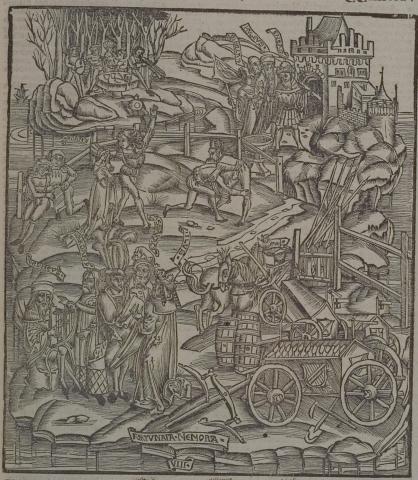Annotations
Aeneas and the Sibyl look upon the Groves of the Fortunate, in Elysium. They watch as, in the center of the image, a pair of men wrestle, a couple dances and another couple sings, reading from a scroll of lyrics (642-4). In the lower left corner, Orpheus plays his lyre (645-7). Next to him, Ilus, grandfather of Priam, Assaracus, grandfather of Anchises, and Dardanus, founder of Troy (Page 499, note 650), stand talking amongst themselves (648-50). In the lower right corner are depicted the arms, carriages, and horses that belong to the shades. The three carriages look a bit odd, like miniature houses on wheels. There are crossbows on the ground next to the carriages, and above the carriages, their spears are propped up against a fence. Their horses, which are supposed to running free and unyoked, are tied to the fencepost of the same fence (651-5). On a small island in the upper corner, a group of shades feast and play music in front of a grove of trees (656-9). The river running around the island is the Eridanus (659). Aeneas and the Sibyl stand talking to Musaeus, a great poet and musician of legend, who directs them toward Anchises (666-78).
Woodcut illustration from the “Strasbourg Vergil,” edited by Sebastian Brant: Publii Virgilii Maronis Opera cum quinque vulgatis commentariis expolitissimisque figuris atque imaginibus nuper per Sebastianum Brant superadditis (Strasbourg: Johannis Grieninger, 1502), fol. 204r, executed by an anonymous engraver under the direction of Brant.


Sebastian Brant (1458-1521) was a humanist scholar of many competencies. Trained in classics and law at the University of Basel, Brant later lectured in jurisprudence there and practiced law in his native city of Strasbourg. While his satirical poem Das Narrenschiff won him considerable standing as a writer, his role in the transmission of Virgil to the Renaissance was at least as important. In 1502 he and Strasbourg printer Johannes Grüninger produced a major edition of Virgil’s works, along with Donatus’ Life and the commentaries of Servius, Landino, and Calderini, with more than two hundred woodcut illustrations. (Annabel Patterson)